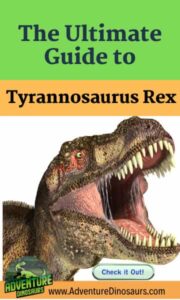Imagine finding a dinosaur skeleton that overwhelmingly changes the game when it comes to one species of dinosaur. That’s what Sue the dinosaur represents to the world. It’s not just a general type of dinosaur but the most well-known of dinosaurs – the Tyrannosaurus Rex. The discovery of Sue is a fantastic story, and the things we learned from this dinosaur fossil continues to give insights we suspected, but now can be confirmed as true.
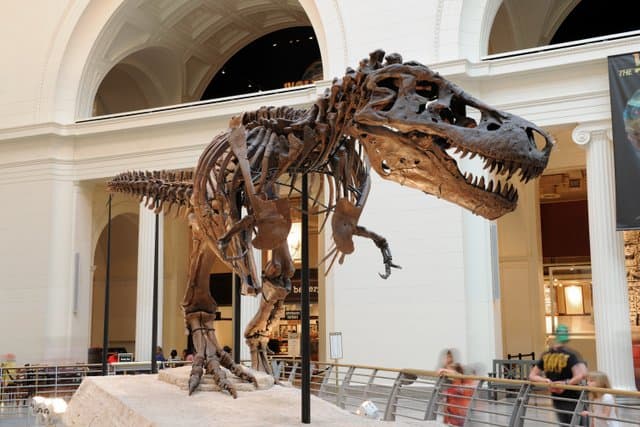
What Are Some Surprising Facts About Sue the Dinosaur?
So what is Sue the dinosaur? Sue is a T-Rex fossil found in South Dakota in 1990. It is the most complete T-Rex skeleton, over 90% complete. The fossil has led to many scientific insights about the T-Rex. Its skeleton was so well fossilized that information about the injury it sustained when it lived as well as how it died, was well preserved. It is a real treasure for the scientific community to study and for the public to see.
In 1990, Sue, the most complete Tyrannosaurus Rex fossil to date, was unearthed in the wide expanses of South Dakota’s Cheyenne River Indian Reservation. This discovery was credited to a fossil hunter from the distinguished Black Hills Institute, following which the dinosaur obtained its name.
However, an unexpected legal battle ensued over Sue’s custody. Maurice Williams, the owner of the land where Sue was found, laid claim to the fossil, sparking a complicated dispute under the U.S. Federal Laws. After a protracted legal contest, the fossils were auctioned at Sotheby’s, a celebrated auction house.
Table of Contents
The grand Field Museum of Natural History in Chicago emerged as the highest bidder, proudly adding this invaluable piece from the Cretaceous period to its collection. Peter Larson, a well-known figure in paleontology, played a pivotal role in preparing Sue’s skeleton for public display.
As a precious relic from a long-gone era, Sue is more than a mere exhibit. Her well-preserved skeleton offers a unique perspective into her species and the Cretaceous period. Renowned palaeontologists across the globe view her as a key to understanding more about extinct dinosaur species, underlining the crucial role Sue plays in the field of paleontology.
#1 – Without a Flat Tire, Sue The Dinosaur Might Have Never Been Discovered
Back in 1990, the Black Hills Institute initiated a huge fossil hunting expedition that resulted in a remarkable discovery. The expedition was carried out on the Cheyenne River Indian Reservation in the State of South Dakota in the USA (Source).
The researchers from the Institute spent an entire summer searching for fossils, and they were very excited to find Edmontosaurus bones. Their leader and president of the Black Hills Institute, Peter Larson, was satisfied with the findings and determined that they could all head back home.
The Flat Tire
The worst luck for Peter Larson was about to strike. However, it proved to be the best of luck for the scientific community and paleontology in general. The group suffered a delay from leaving when their truck punctured its tire.
A majority of the group went near the city of Faith in South Dakota to repair the flat tire, but Sue Hendrickson stayed back. She wanted to do some further exploration because she felt that they had not exhausted the possible fossil sights. They still had not explored some hills, but they wanted to leave. She would at least cover some more ground, while the rest of the team took care of their transportation issues.
Because of that flat tire, Sue Hendrickson was about to make one of the most extraordinary fossil discoveries. It’s arguable that if she didn’t have time to wander around alone, Sue the dinosaur might not have been found.

Sue explored the base of a cliff and discovered some bones. On tracing their origin, she realized that something big was buried under the cliff. Some big bones were protruding out of the sides of the hill.
Convinced that she had just made a huge discovery, she immediately rushed back to the paleontology camping site. She presented her findings to Peter Larson. He identified the bones from their contours and asserted that they were from a T-Rex. Some crew members still went home, but Sue and others remained for the excavation.
If Sue Hendrickson hadn’t stayed back to find the partially exposed bones of the FMNH-PR 2081 specimen, there is a chance it might never have been discovered and would be completely destroyed by now.
#2 The T-Rex Sue is the Most Complete Dinosaur Skeleton with Over 90% Recovered
Previously, paleontologists have never discovered T-Rex skeletons that were even nearly half as complete. Since the T-Rex species was massive, it is only probable that most of their fossils were ruined and scattered. Therefore, the discovery of Sue the dinosaur was a big deal. The dinosaur bones were estimated to constitute 90% of the animal’s full skeleton.
The discovery of Sue caused ripples in scientific circles around the world. It caused significant excitement among paleontologists and even in Hollywood. The fossil, cataloged as FMNH-PR 2081, is the best-preserved dinosaur specimen ever discovered.
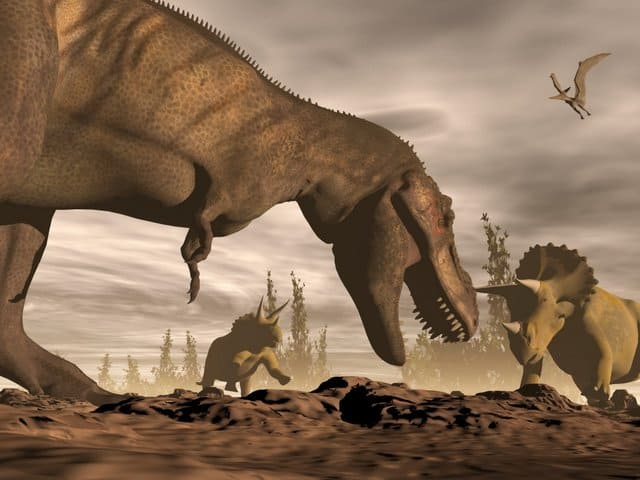
It was very well preserved. A few of the fractures or breakages were incurred after its death. The skeleton was collapsed, and the hipbones were found over the skull. Its legs and ribs were also intertwined, but every bone was in good shape and condition. As expected, most of its teeth were present and in an impressive condition.
In the following table, I lay out some of the basic topics and specifications of the T-Rex fossil. In the first column, I list the topic. In the second column, I give the specification, and in the third column, I give a brief description or comment.
Table 1 - Interesting Topics and Specifications of Sue the Dinosaur
| Topic | Specification | Description or Comment |
|---|---|---|
| Classification | Class - Archosauria; Order - Saurichia; Family - Tyrannosauroidea | Extinct |
| Timeframe | Late-Cretaceous | |
| Measurements | Sue is 40 ft long and estimated to be 9-15 tons (8-14 metric tonnes). Skull weighs 600 lbs (272 kg) | Sue is not the largest T-Rex found, but the most complete |
| Where Fossil Found | South Dakota | Found by Sue Hendrickson, an American explorer and fossil collector |
| Unique Findings About the Fossil | 250 of the 360 known T-Rex bones were found. Most complete T-Rex tail, longest T-Rex tooth, Age estimated to be 28 when it died | |
| Price Fossil Sold | $8.3 Million to Field Museum in Chicago | Sponsors - ● Walt Disney Parks and Resorts ● California State University system ● McDonald's ● Ronald McDonald House Charities |
| Currently Exhibited | Field Museum in Chicago, USA | Skull exhibited in separate room |
| Topic | Specification | Description or Comment |
Scientists tried explaining why the T-Rex was in excellent condition despite the rarity of such a discovery. According to the most accepted theory, Sue was covered in mud soon after it died. Because of the mud, other animals did not scavenge on Sue’s remains. Rushing water had also compacted the bones together, and that helped to prevent scattering.
#3 Sue’s Wishbone – The First-Ever Found on a T-Rex – Confirms a Closer Link To Dinosaurs and Birds
Scientists are always trying to collect as much information on the different Jurassic species that existed. They are more wanderlust than most other people; they travel from one region to the other in such dinosaur skeletons to reconstruct the ancient past for a beautiful future. Paleontology experts around the world, from Asia to America, interact and share notes.
Considering the many fossils discovered before and after Sue, scientists had a reason to be excited about the huge and almost complete T-Rex skeleton. For starters, the almost perfect condition of the carnivorous reptile leaves little for the imagination. While, previously, scientists had to rely mainly on estimations and scientific creativity, Sue came to fill in the missing pieces of information. Sue’s discovery was a big affirmation to the discipline of paleontology.
One of the unique bones that Sue the dinosaur had was the furcula – the wishbone – which is commonly found in birds (Source). In fact, it was the only furcula that has been found in T-Rexes prior to Sue’s discovery. The finding of it confirms dinosaurs had a close link to birds.
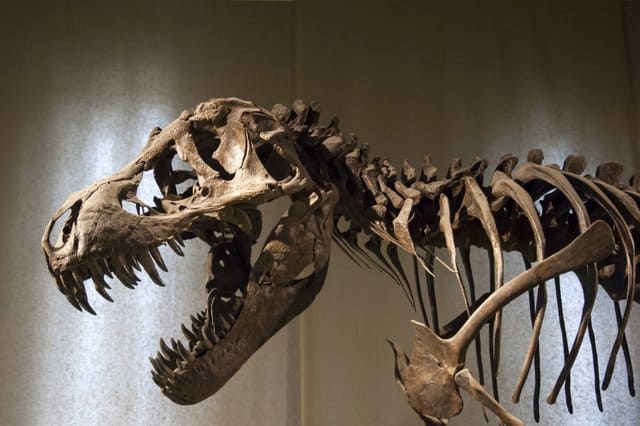
Sue the Dinosaur Helped Paleontologists Piece Together Other Partial Skeletons
Paleontologists have to find the fossils deep in the ground and below hard rock layers. Fossilization happens when an ancient animal is engulfed, and all the flesh decays, leaving the bones and other hard parts preserved. Due to animal activities and geological events, even perfectly preserved skeletons may get tampered with, damaged, and scattered. If you want to learn more about the fossilization process, check out my article here.
It may be tempting to think that dinosaur skeleton discoveries happen easily and romantically. It’s actually a lot of hard work, with the patience needed and sometimes a hit and miss adventure.
Paleontologists don’t just see a bone sticking out of a hillside and excavate only to find the full skeleton of a gigantic dinosaur. Most bones found are always shuttered, broken, disjointed, fragmented, and disarticulated.
Sometimes, scientists are unable to figure out which bones belonged to which dinosaur when they find two or three skeletons of different dinosaurs huddled together. Sometimes, paleontologists would preferably find one isolated set of skeleton bones than unearth a confusing puzzle of different and incomplete skeletons on a bone bed.
As technology and international cooperation continue to advance, the scientific community is continuously unearthing valuable information regarding the Jurassic era. However, no matter how many bones the scientists find, one major problem plagues paleontology as a whole.
All the dinosaur bones and skeletons that scientists continue to discover are never complete. They are always collapsed, damaged, and scattered. Some are even on top of each other, doing the puzzle of reconstructing the skeleton a difficult task.
————————————————————————————————
Related Dinosaur Articles You Might Also Be Interested In:
Would A T-Rex Really Shake The Ground?
What’s the Value of a Real Dinosaur Tooth (Single, On Jawbone)?
How Would A T-Rex Get Up After Falling?
————————————————————————————————
In the case of Sue, because it was such a complete dinosaur – skull, torso, ribcage, hind legs, and tail – it helped confirm the construction of other T-Rexes that might not be able to put together easily. The beauty of Sue the dinosaur is that because 90% of the skeleton was recovered and then assembled, it serves as a “map” or example for other T-Rex fossils.
#4 Sue the Dinosaur Has a Total of 58 Teeth
The first striking thing one looks at when seeing a carnivore dinosaur skeleton, is normally how big it is. After that, one looks at the teeth to see how many and how big they are. In the case of Sue, the T-Rex had a total of 58 teeth, most of them still connected to the jawbone!
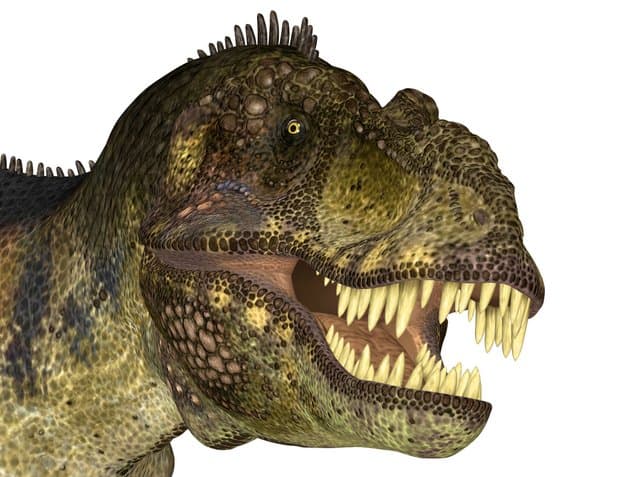
Record for the Longest T-Rex Tooth
Sue’s set of teeth also has a record. The skeleton holds the record for the longest T-Rex tooth at 12 inches long (30.5 cm)! Most of the teeth are a dark brown color, due to the fossilization process and rather flat but pointed, the shape being similar to a banana. (Source)
The Skull of Sue the Dinosaur
The skull of any animal disintegrates into its various comprising parts after death. It is considered to be an extremely valuable fossil, and it tells a lot about the animal species. The skull does not have any joints holding the different parts together.
Thus, it can be extremely frustrating for paleontologists to reconstruct a skull when some parts are missing. They always have to rely on teeth, which are typically the most preserved skeleton parts (the enamel leads to better fossilization), to figure out information regarding a fossil.
The multiple holes on Sue’s skull provided conclusive evidence that the carnivore starved to death. It was most probably infected by a protozoan parasite that causes the internal swelling of a host’s neck. Sue later suffered some damage on the back of her skull after her death. The gushing water probably damaged the riverbed.
We are lucky that the skull of Sue was preserved as well as it was. As mentioned, many of the details were fossilized, and it adds to the knowledge of how Sue lived and eventually died.
#5 Sue’s Sense of Smell (Olfactory Nodes) Were Bigger Than Her Cerebrum
Another amazing thing that came out of studying Sue the dinosaur’s skull is that scientists have recognized that the olfactory nodes in the skull – basically the part of the skull that enables a sense of smell, were bigger than the cerebrum (Source). It means that the smelling capability of the T-Rex, based on the skull studies, indicates that Sue’s sense of smell was highly developed.
The T-Rex’s keen sense of smell helped it to be a better predator, finding prey by smell rather than sight.
❖ Read Now! The Ultimate Guide to Tyrannosaurus Rex
The main article in the series, it is packed with information all about the King of the Dinosaurs. it provides information about the first discovery, some of the latest fossil findings, and covers the anatomy of the dinosaur. Following this, it provides a look at the classification and phylogeny. The places, where T. Rex fossils have been found are described and a few of the key fossil skeletons are described. The master article also covers:
—Interesting facts you may not know about T. Rex
—Unanswered questions about the T. Rex
—Links to the Series Articles (17 in total!) which give deeper info on the dinosaur.
#6 The Age of Sue is Estimated to Be 28 Years Old
Scientists studied Sue carefully through the use of DNA and RNA technology. They also had established T-Rex experts and other paleontologists trying to decipher the life of Sue the dinosaur. They estimated that the predator must have lived up to 28 years (Source) before it died.
Even with comparative studies dispensed, paleontologists were unable to speculate their gender. Twenty-eight years was a remarkable age for a T-Rex, and Sue was deemed the oldest T-Rex until scientists found Trix 23 years later in 2013.
How Did Sue the Dinosaur Die?
Sue’s remains were covered in mud and huddled by rushing water. Further epistemology of her remains suggests that she died on a seasonal streambed. The rushing water and mud helped to preserve her remains, but the water washed away some of her smaller bones when huddling the rest together.

How Sue died is not known for sure, but close examination of the skeleton and skull reveal that the carnivorous reptile suffered numerous ghastly injuries in her lifetime. She may have died from her injuries, from an accident or was attacked by other dinosaurs. Old age may have also been a cause.
She had an injury on her right shoulder and a torn tendon in the right arm. Pathologists attributed the torn ligament and damaged shoulder blade to violent hunting activities.
The injuries must have been incurred simultaneously with the three broken ribs on her right side. All the fractures healed, but one rib never fused back into one piece. Sue may have survived that hunting experience, but it almost took her life.
Other clues that scientists discovered regarding this precious and rare T-Rex fossil was that Sue suffered arthritis due to injuries. The predator must have led a very violent life, but such is the life of any carnivorous creature. Sue also suffered from gout at some point in its life, and a probable infection halved its right fibula.
#7 Sue the Dinosaur Sold for Over $8 Million
Who Owns Sue the Dinosaur?
The discovery of Sue was marred with very adversarial litigation. The Federal government wanted in on a piece of the large pie. FBI investigations on Peter Larson led to his imprisonment for two years. The investigative bureau raided the Black Hills Institute and seized Sue for the entire period within which the criminal and civil litigations spanned. In the end, the courts determined Sue belonged to the landowner from which the fossil was excavated.
Maurice Williams then put Sue on auction. The Field Museum desired to acquire Sue in a bid to prevent the fossil from falling under private ownership. It lobbied popular brands to help finance Sue’s acquisition, and the following brands chipped in the venture:
● Walt Disney Parks and Resorts (Jurassic Park)
● California State University system
● McDonald’s
● Ronald McDonald House Charities
In 1997, The Field Museum purchased Sue’s Skeleton for $8,362,500. In a bid to satisfy its sponsors, The Field Museum partnered with them to establish research facilities. It cleaned the bones carefully and removed the entire skeleton. It also allowed, true to its vision and promise, millions of people to watch the cleansing process.
The team made plastic molds for the 10% of missing bones to complete the exhibit, but the plastic bones were colored purple so that people could tell they weren’t real. Finally, the team used the bones to make several sets of cast plastic bones.
Where is Sue Currently Exhibited?
If you want to see Sue’s skeleton in person, you must travel to Chicago, USA to the Field Museum. The T-Rex is currently housed in the Griffin Halls at the Evolving Planet exhibit. Her mold casts are also mounted at Disney’s Animal Kingdom in Florida.
Currently, Sue is under display in the Evolving Planet exhibit hall. The hall was built specifically to suit displays matching the wealth of information emanating from studies conducted on Sue. The display features animated videos depicting Sue’s powerful hunting habits and prowess. Sue’s skull, however, is kept in a different display gallery that allows for easy and transparent scientific studies on it.
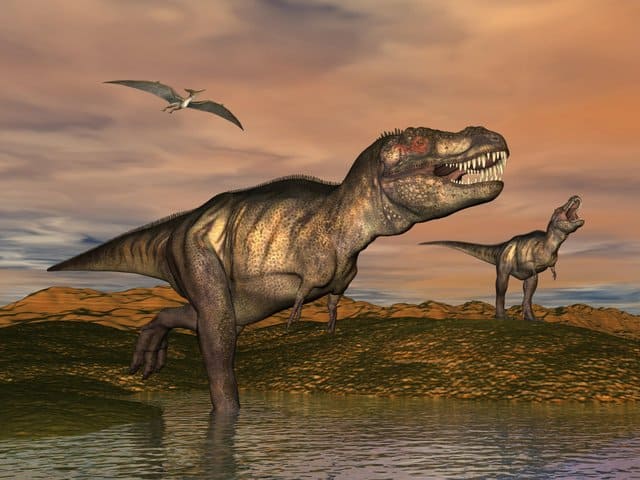
Where Can You See Other T-Rex Skeletons
You can find other T-Rex specimens (name of T-Rex and display number) on display at (Source):
● Museum of the Rockies: T-Rex -Wankel (MOR 555) Montana, USA
● Black Hills Institute of Geological Research, Inc.: T-Rex – Stan (BHI 3033): South Dakota
● Natural History Museum of Los Angeles County: T-Rex – Thomas (LACM 150167)
● Naturalis Biodiversity Center: T-Rex – Trix (RGM 792.000) Leiden, The Netherlands
● T-Rex Discovery Centre: T-Rex – Scotty (RSM 2523.8): Eastend, Saskatchewan
● Carnegie Museum of Natural History: T-Rex – Holotype (CM 9380): Pittsburgh, PA
Final Thoughts
The Tyrannosaurus Rex is one of the most popular and well-known dinosaurs. See my article: The 13 Best-Known, Most Loved Dinosaurs and Why. For decades the world went without a full skeleton; it had only a partial visual view of this exceptional predator. All this changed with the discovery of Sue, thanks to Sue Hendrickson and the paleontology team that helped to excavate it. We are lucky to be able to benefit from the knowledge that the skeleton brings to the world of dinosaurs and also to get a real live view of the dinosaur skeleton in all its detail.

